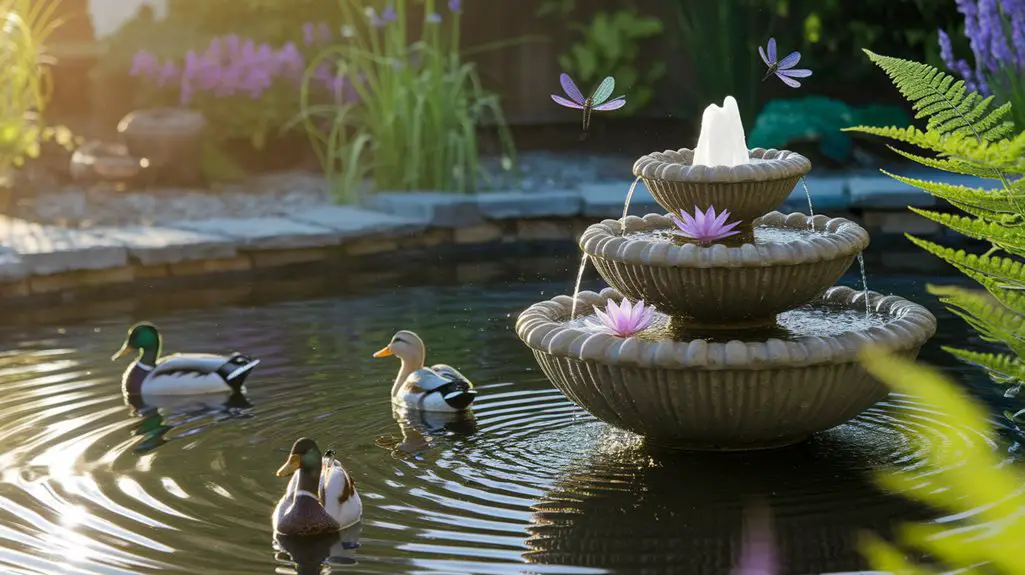Imagine a well-designed backyard featuring a bird bath nestled among native foliage, bringing vibrant bird life to your space. A strategically placed pond introduces biodiversity, supporting amphibians and aquatic insects. Meanwhile, a cascading waterfall enhances the sensory landscape, providing soothing sounds and essential aeration. By integrating these water features, you lay the groundwork for a thriving wildlife habitat. Discover how each element contributes to creating a garden that teems with life.
Bird Baths
A bird bath can be an important focal point in your backyard, offering not just aesthetic appeal but also a significant resource for avian visitors.
Selecting materials like cast stone or ceramic enhances durability and temperature regulation. Design considerations include a shallow basin with a non-slip surface to guarantee safety and accessibility for birds.
Incorporating a drip or mister element can create dynamic motion, attracting a diverse array of species while preventing stagnation. Position your bird bath in an area with partial shade, guaranteeing protection from predators by avoiding proximity to dense foliage.
Regular cleaning and water replacement are vital for preventing algae growth and mosquito proliferation, optimizing the health benefits for visiting birds. Additionally, providing native plants near the bird bath can enhance the habitat and attract more wildlife.
Integrate these elements to elevate both form and function in your wildlife-friendly garden.
Ponds
While bird baths offer a delightful attraction for avian visitors, a well-designed pond enhances your backyard by supporting a broader ecosystem.
You'll create a haven for amphibians, insects, and aquatic plants, boosting biodiversity. Incorporate native plant species like pickerelweed and water lilies for natural filtration and habitat.
Ensure proper pond depth—18-24 inches encourages ecological balance while preventing algae overgrowth. Implement a recirculating pump to maintain oxygenation, essential for pond health.
Adding shelved areas within the pond supports varied wildlife, offering shallow refuge for amphibians and safe breeding grounds.
To attract dragonflies and frogs, design with subtle curves and gentle slopes, mimicking natural water bodies. Install a gravel substrate to support beneficial microbes, enhancing water clarity and promoting a thriving aquatic environment. Additionally, consider including wildlife-friendly plants that can provide shelter and food sources for various creatures in your pond.
Waterfalls
When implementing a waterfall in your backyard, prioritize its integration within the existing landscape to maximize ecological harmony. Position the waterfall strategically to guarantee ideal water circulation and aeration, which enhances habitat sustainability.
Select natural, local stones to create an authentic geological appearance, ensuring seamless cohesion with your surroundings. The sound of cascading water serves as an acoustic attractor for wildlife, while promoting mental tranquility for residents. Additionally, incorporating backyard entertainment zones can draw more wildlife by providing diverse habitats.
To visualize your design, consider these critical components:
- Gradient: Adjust slope intensity to influence water velocity and noise level.
- Basin: Craft a wide catchment area to support aquatic life and overflow management.
- Filtration system: Install natural or mechanical filters for crystal-clear water.
- Vegetation: Incorporate native aquatic plants for habitat enrichment.
- Lighting: Use submersible LEDs to accentuate water movement, enhancing nighttime aesthetics.
Conclusion
Incorporating these water features into your backyard is like setting the stage for a vibrant wildlife symphony. Bird baths offer safe havens for avian visits, while ponds support a thriving ecosystem of amphibians and insects. Waterfalls enhance both beauty and aeration, their gentle sounds beckoning a diverse array of creatures. By designing with native plants and considering placement, you'll create a dynamic, sustainable habitat that attracts wildlife, enhances biodiversity, and elevates your garden's ecological harmony.




